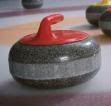Curling
I can see how curling is sort of like watching grass grow to many people. I don't pretend to know the first thing about it, but it's somehow fascinating to me. So, either read the rest of the post, or go away and find something else to do :D
The History of Curling
The oldest artifacts from the ice sport of curling are stones, today extant but unknown, which prehistoric people slid toward a target along frozen rivers or lakes. These people may also have used primitive brooms to clear snow from the path of their sliding stones.
In 1565, Holland’s Peter Breugel painted "Hunters in the Snow" and another work depicting scenes resembling modern curling. Breugel’s paintings support the premise held by some that curling originated in continental Europe. The Scots, however, are the undisputed developers and formalizers of the modern game. By 1638 curling was considered, with golf and archery (in M. H. Adamson’s poem The Muses Threnodie), to be a usual recreational pastime. After a huge growth spurt in the 19th century, curling was played by thousands in nearly every Scottish parish.
Between the 16th and 20th centuries, Scotland’s climate warmed, and today the lochs rarely freeze. The climate change hindered curlers, who played outdoors on natural ice until the 20th century. Nonetheless the Scots had, by the mid-1800s, formalized curling’s rules of play and equipment and had established the "mother club" of curlers worldwide, the Royal Caledonian Curling Club. The RCCC is today the national governing body of curling in Scotland, with 20,000 active members now playing indoors on refrigerated ice.
The game of curling spread throughout the world through the efforts of thousands of Scottish soldiers and émigrés. In North America, curling’s origins likely date to the late 1700s. The first documented record is the founding of the Montreal Curling Club in 1807.
In 1832, the Orchard Lake Curling Club, near Detroit, became the first curling club in the United States, organized at the home of Dr. Robert Burns. The Orchard Lake group curled on Lake St. Clair. The oldest continuously operating curling club in the United States is the Milwaukee, Wisconsin club, founded in 1845. The Scottish founders’ roster included such names as Murray, Ferguson, Dunlop, Gunyon, Findlay, Kinney, McFarland and McFadyen.
Since the mid-1800s, curling has spread and thrived in northern states, including Wisconsin, Minnesota, and North Dakota, and also in the Great Lakes, New England and mid-Atlantic states. There are dedicated pockets of curling activity in other states, including Alaska, Washington, California, Texas, Colorado, Nebraska, Kansas, Missouri and North Carolina. In all, there are active curling clubs in 26 states in the nation.
In the United States today, there are over 15,000 curlers in over 135 clubs, most of which own their ice facility. While many U.S. curlers have Scottish roots, modern curling club membership rosters tend to reflect an ethnic cross-section of their communities, which are preponderantly small-town rural. The largest curling club in the USA is the St. Paul, Minnesota, club, with over 700 members.
The United States Curling Association (founded 1958) governs curling in the USA. Like that other Scottish sport, golf, curling is both a recreational and an athletic pastime, marked by a strong code of fair play and courtesy (The Spirit of Curling). The USCA is a member of the U.S. Olympic Committee and the World Curling Federation, and has 131 member clubs in 11 regions. Curling debuted as a medal sport in the 1998 Winter Olympic Games in Japan. About 1.5 million people from ages eight to 80 in over 33 countries curl.
The best-known American curler is Raymond "Bud" Somerville, of Superior, Wisconsin, the first inductee into the USCA’s Hall of Fame. Somerville skipped his team to its first world championship in 1965, at age 28. In 1992, at age 55, he skipped his team to a bronze medal at the Albertville Olympics (curling was a demonstration sport).
The ice sport of curling, although never well known in the United States, has developed steadily throughout American history. The sport is often passed down through families and has provided enjoyable winter recreation to thousands of Americans.
And from the World Curling Federaltion
Curling is an extremely complex sport based around a very simple idea. Slide a stone down a sheet of ice and have it stop as near the centre of a set of rings (called house), the problem being that your opposition will do everything tactically to stop you from achieving this goal. So the game contains elements of great skill, strategy, finesse, exertion and endeavour and we promise you that the perception of a slow-paced game is just that, a perception.
The game itself is more than 500 years old and its' true origin is hidden in the mist of time, but it was in Scotland the game evolved during the centuries and also where the mother club of curling, The Royal Caledonian Curling Club was formed in 1838. The game has of course evolved through the years and the latest change on how the game is played was introduced in 1990 when the free guard zone rule was introduced.
Fairness is an important part of the game and you shall not be surprised if your opponent will point out to you that they have broken the rules so just to make sure that no advantage is given.

1 comment:
There was a comment posted here, but since it had nothing to do with any subject matter on this site, I decided to delete it. If the poster would like to email me about it, my email is on the sidebar.
Post a Comment